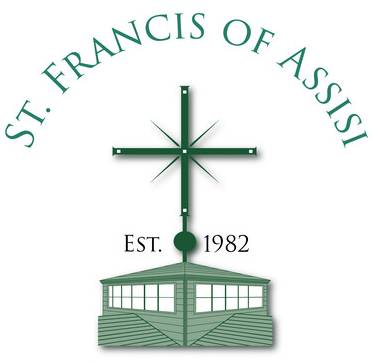Parish History
History of St. Francis of Assisi Catholic Church
Saint Francis of Assisi Catholic Church was established as a parish on April 25, 1982 after Bishop Joseph Gossman recognized the rapid growth of the Catholic population in northwest Raleigh. According to parish legend, there were two choices for the name of the parish, St. Ignatius of Loyola, the Jesuit patron of first pastor, Fr. Jim English, SJ or St. Francis of Assisi, Franciscan patron of his good friend, Fr. Bob Hudak, OFM. If the day the land was dedicated was sunny, the parish would be named after St. Francis. If it was a rainy day, St. Ignatius would be chosen. The day was beautiful and sunny. Saint Francis of Assisi Catholic Church was born. 125 families were registered at the time.
The original church, dedicated in 1983, held 450 persons. It was designed to resemble a barn, an inspiration also carried out in later construction. The wooden beams in the sanctuary (now Anthony Hall) and the parish office (now Elizabeth Hall) were retrieved from old buildings being razed in the northeast. Marks of their former use are still visible, such as holes where bolts were formerly located.
In July 1987, Franciscan Friars of Holy Name Province were invited by Bishop Gossman to minister at our parish. When Fr. David McBriar, OFM became the second pastor of the parish, we became a leader in social outreach and a faith community known for welcoming all who came to our doors.
As the parish grew, so did parish ministries. A new Parish Center, now named Clare Hall, was dedicated in 1991. It was filled every night within a year of its completion. The St. Francis Preschool opened its doors in 1991 as well.
With overflow crowds regularly standing outside the church during liturgies, construction of a larger church became a necessity. Architect Jon Condoret was chosen because of the simplicity of his designs, his use of natural light and his talent for blending the old with the new. He created a new worship space that “fit” with existing buildings. Brother Frank Kacmarcik, OSB a renowned liturgical design consultant, was chosen to work with Jon Condoret. The design of our church encourages the full, active participation of everyone present so that each worshiper who is a member of the Body of Christ, in solidarity as a worshiping community, can receive the Body of Christ in order to go forth to be the Body of Christ for others.
Our parish was one of the first Catholic Churches in the United States to have a columbarium, a resting place for those who have died and been cremated. Walking through our Memorial Garden on the way to the church, we are reminded that we are linked together in death as in life. We are passing through, travelers one and all, incorporated in the Body of Christ, one day to be united with God, never to die again.
Fr. Dan Kenna, OFM became the third pastor of our parish in September 1995, just before the church and columbarium were dedicated in 1996.
With the growth of the Catholic population in the diocese, the need for parochial schools became apparent. Our parish was considered one of the most desirable locations for a new school. The Franciscan School was dedicated in 2000.
In 2004, Fr. Mark Reamer, OFM became our fourth pastor. He carried forth the mission of welcoming all who come to us, outreach to the least amongst us, and empowerment of the laity. Under Fr. Mark’s guidance, we added St. Mary of the Angels Chapel, the Assisi Community Center, the Siena Center for Lifelong Learning, and an expansion of St. Francis Preschool.
Fr. Steve Patti, OFM became our fifth pastor in 2014. During his time as pastor, Holy Name Province made the difficult decision to conclude its ministry at St. Francis of Assisi due to the decreased number of Franciscan friars for their many locations.
For the first time since its founding, a diocesan priest, Msgr. Michael Clay, was named as pastor of our parish in 2020. Like his Franciscans predecessors, the social justice mission of the Catholic Church and a welcome to all who come to our doors remain high priorities. In a desire to retain our identity as a parish under the patronage of St. Francis, he has overseen the creation of the Franciscan Garden, a place of beauty for rest, prayer, and reflection with art and biographies of the Franciscans whose names adorn several of our buildings.
***
For a more in-depth history of our first thirty years, click here.
***
Learn about the rich history of our Diocese, click here




